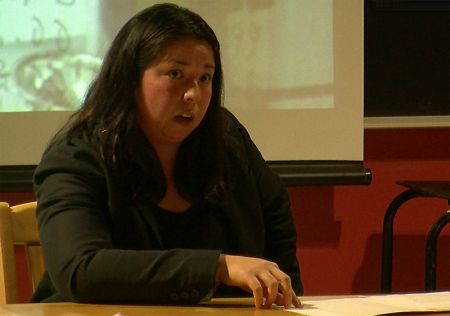Ursula Johnson introduces herself in Mi’kmaw, then in French and, finally, in English. She calls herself Little Bear, pointing to her black t-shirt encased in a black blazer. Next, she describes herself as “lnu'sgw”: the Mi’kmaw word for a Native woman.
Johnson is speaking to a group of forty odd University of King’s College students and professors. She has been invited to give the semester’s final lecture in a series entitled “Conceptions of Race in Philosophy, Literature and Art.” Her topic on the evening of Dec. 7 is “Identity, ancestry, and cultural practices,” a subject that couldn’t be more apt for an artist who, as her myriad of introductions suggest, is struggling with the idea of identity herself.
“I am not an Aboriginal artist. I am an artist who is Aboriginal,” she says.
Johnson, 30, was born in Sydney, Cape Breton and raised in Eskasoni First Nation, the largest Mi’kmaw community in the world. She graduated from the Nova Scotia College of Art Design in 2006, becoming the first of her community to do so. She was also the first member of her family to receive a postsecondary education and permanently move away from the reserve.
“Being in the city, I am away from my language, my culture, my spirituality. I have to work extra hard to have that in my life. You have to put more work into being who you are,” she says.
The art she has created over the past 14 years in Halifax focuses on reconciling the gap between her community, her culture, her ancestry—and her redefinition as an “urban Aboriginal." In turn, she hopes her art can help the increasing number of rural-urban Aboriginal migrants do the same.
“My art is informed by my environment. When I lived on the reservation, I created (certain) types of art. When I moved to the city, I created different types of art. Living in the city makes you learn to think and navigate in a different kind of way,” she explains.
According to Johnson, understanding this navigation in “the place you call Halifax,” can be daunting for Aboriginal youth. Her 2008 project, The Urban Aboriginal Guide to Halifax, drew on her own experiences as a bewildered teenager moving to the metropolis and the experiences of her counterparts at the Mi’kmaq Native Friendship Centre where she volunteered.
The piece consists of a stylized map of Halifax, Dartmouth and Bedford with an accompanying guide of articles explaining where to find food, shelter and elements of Native culture in HRM. Although it was partly meant as a satirical take on colonization, a reversal of white-Native roles, the Mi’kmaq Native Friendship Centre requested copies for distribution as an actual guidebook for Aboriginal migrants.
This demand illuminated for Johnson the cultural losses and disconnect faced by Aboriginals who make the move to Halifax. “In the city, you do not have the same type of family networking or community,” she says.
This sense of isolation, she explains, is furthered by a difference in language. Johnson laments not having very many people with whom she may converse in Mi’kmaw. To aid in the retention of her native language, Johnson conceptualizes her art in Mi’kmaw and creates what she describes as an English product that is digestible for urban audiences.
Nations in a Circle was one such piece. Johnson spent three days weaving a basket around herself, providing a outward display of Aboriginal craft and allowing herself to inhabit a cocoon of Mi’kmaw culture. When asked by a spectator how she planned to escape the basket, Johnson jokingly replied that perhaps that was not her intention. Despite her tone, Johnson’s response demonstrates the urge to use art as a cultural stronghold in a city where she has never quite felt accepted.
Johnson’s more recent work at Nocturne demonstrates Haligonians’ unease of facing racial issues concerning the treatment of Aboriginals in the past and present. Her performance, which featured her sporting a basket weave headdress that was ‘scalped’ by a participant, left many festival-goers uncomfortable and even angered: a reaction Johnson attributes to people being afraid to ask questions.
She is currently attempting to answer some of those questions of identity, culture and ancestry—for herself, for urban Aboriginals and anyone else willing to listen—by incorporating traditional storytelling practices into her artwork.
But has Johnson determined an ultimate answer for herself?
She has sorted out the confusion as to her identity as such: she is both a representative of Aboriginals who has left the reservation to speak for her people and a member of the reserves who has emerged to fight for their cause.
“I never quite got it,” says Johnson of being a reservation-cum-urban Aboriginal, “but I get it now.”



